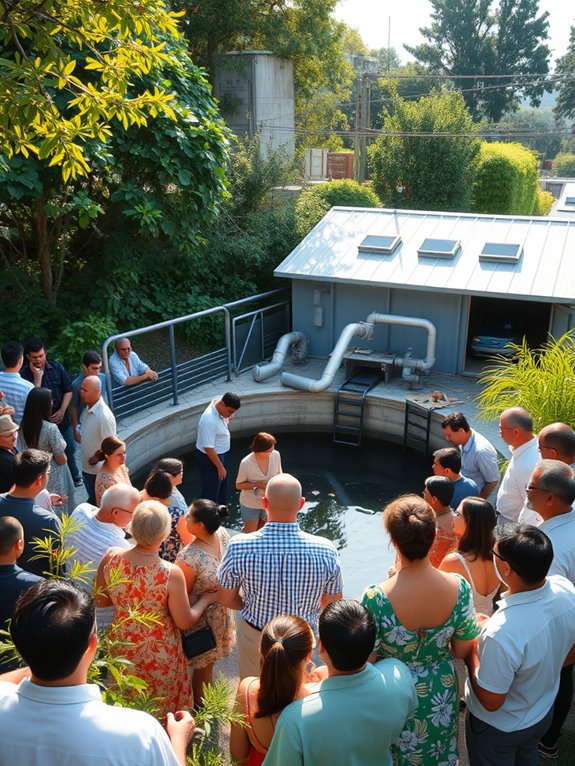Water treatment plants are designed to keep your drinking water safe. They use processes like coagulation, filtration, and disinfection to remove harmful contaminants. Regulatory agencies set strict standards to guarantee water quality, but challenges like aging infrastructure and climate change can impact safety. Community involvement plays a key role in maintaining transparency and addressing concerns. It's important to stay informed about how these factors affect your water supply and what solutions are being implemented.
Understanding Water Treatment Processes

When you understand water treatment processes, you can appreciate the complexity and significance of providing safe drinking water. Each step, from sourcing raw water to final distribution, plays an essential role.
You'll learn about coagulation, where chemicals help particles clump together, making them easier to remove. Filtration follows, trapping remaining impurities.
Disinfection is critical, ensuring harmful microorganisms are eradicated, often using chlorine or UV light. Finally, water is tested for safety before entering your tap.
Common Contaminants and Treatment Methods
Understanding the common contaminants found in water can help you appreciate the importance of effective treatment methods. You might encounter bacteria, viruses, heavy metals, and chemicals in your water supply.
Treatment plants typically use filtration, chlorination, and reverse osmosis to remove these impurities. For instance, filtration captures larger particles, while chlorination disinfects pathogens.
Reverse osmosis helps eliminate smaller contaminants like lead or nitrates. Each method targets specific threats, ensuring your drinking water is safe.
Regulatory Standards and Safety Measures

Regulatory standards play an essential role in ensuring the safety and quality of drinking water. You benefit from stringent guidelines set by agencies like the Environmental Protection Agency (EPA). These regulations dictate acceptable levels of contaminants, monitoring requirements, and treatment processes.
Water treatment plants must regularly test their water and report results to maintain compliance. By adhering to these standards, they help protect you from harmful substances. Additionally, safety measures like proper equipment maintenance and employee training are vital.
When you understand these regulations, you can feel more confident in the safety of your drinking water and the effectiveness of local treatment facilities.
Challenges Faced by Water Treatment Plants
Although water treatment plants play an essential role in ensuring safe drinking water, they face numerous challenges that can hinder their effectiveness.
Aging infrastructure often leads to leaks and contamination risks, while increasing population demands strain resources.
You might also notice that climate change affects water sources, introducing new contaminants and altering supply.
Additionally, funding limitations can restrict necessary upgrades and staff training.
These factors make it difficult for treatment plants to maintain consistent water quality.
As a result, staying informed about these challenges is vital for understanding the overall safety of the water you consume.
The Role of Community Engagement in Water Safety

Community engagement plays an essential role in enhancing water safety, especially as water treatment plants tackle ongoing challenges.
When you get involved, you help foster open communication between residents and water authorities. This connection guarantees that your concerns and suggestions are heard.
Regular community meetings and outreach programs can educate you about local water issues, making you an informed advocate for your community's needs.
By collaborating with water treatment professionals, you can contribute to effective solutions and promote transparency, ultimately leading to a safer water supply.
Your participation makes a difference, ensuring that everyone has access to clean and safe drinking water.
Conclusion
In summary, while water treatment plants play an essential role in ensuring safe drinking water, they aren't without challenges. Did you know that nearly 25% of Americans rely on community water systems that may struggle with outdated infrastructure? This highlights the importance of regular maintenance and upgrades to keep our water safe. Engaging with your local water authority can help address concerns and push for improvements, ensuring you and your community have access to clean, safe water.

I’m Allen Kim, the chief editor of plumbinginto. I am a mid level plumber and assign to an local firm over 4 years of experience. During the working period, most of my experience is related to the house plumbing. I learned about the thing, when working with most experienced people in this sector, one must be as good as the inspector or better with knowledge of the project as well as the practical aspects of plumbing industry.